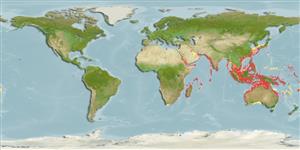>
Tetraodontiformes (Puffers and filefishes) >
Monacanthidae (Filefishes)
Etymology: Paramonacanthus: Greek, para = the side of + Greek, monos = one + Greek, akantha ) thorn (Ref. 45335).
More on author: Rüppell.
Environment: milieu / climate zone / rango de profundidad / distribution range
Ecología
marino demersal; rango de profundidad 28 - 79 m (Ref. 33065). Tropical
Indo-West Pacific: Red Sea to South Africa and northern Australia (excluding the northeastern region), north to southern Japan.
Tamaño / Peso / Age
Madurez: Lm ? range ? - ? cm
Max length : 14.6 cm SL macho / no sexado; (Ref. 33065)
Short description
Claves de identificación | Morfología | Morfometría
Espinas dorsales (total) : 2; Radios blandos dorsales (total) : 25 - 30; Espinas anales: 0; Radios blandos anales: 24 - 29; Vértebra: 19. Body width 2.0-2.8 in head length; body depth 1.9-3.0 in SL; head length 2.6-3.0 in SL; snout length 3.5-4.1 in SL; eye diameter 2.8-4.8 in head length (Ref. 33065).
Body shape (shape guide): short and / or deep; Cross section: compressed.
Inhabits mud or sand bottoms of trawling grounds (Ref. 90102).
Life cycle and mating behavior
Madurez | Reproducción | Puesta | Huevos | Fecundidad | Larva
Hutchins, J.B., 1997. Review of the monacanthid fish genus Paramonacanthus, with descriptions of three new species. Rec. West. Aust. Mus. Suppl. No. 54:1-57. (Ref. 33065)
IUCN Red List Status (Ref. 130435: Version 2025-1)
Threat to humans
Harmless
Human uses
Pesquerías: bycatch
Herramientas
Special reports
Download XML
Fuentes de Internet
Estimates based on models
Preferred temperature (Referencia
123201): 23.3 - 28.4, mean 27.4 °C (based on 437 cells).
Phylogenetic diversity index (Referencia
82804): PD
50 = 0.5000 [Uniqueness, from 0.5 = low to 2.0 = high].
Bayesian length-weight: a=0.01995 (0.00956 - 0.04164), b=2.93 (2.76 - 3.10), in cm total length, based on LWR estimates for this (Sub)family-body shape (Ref.
93245).
Nivel trófico (Referencia
69278): 3.2 ±0.3 se; based on size and trophs of closest relatives
Resiliencia (Referencia
120179): Alto, población duplicada en un tiempo mínimo inferior a 15 meses (Preliminary K or Fecundity.).
Fishing Vulnerability (Ref.
59153): Low vulnerability (10 of 100).
🛈
